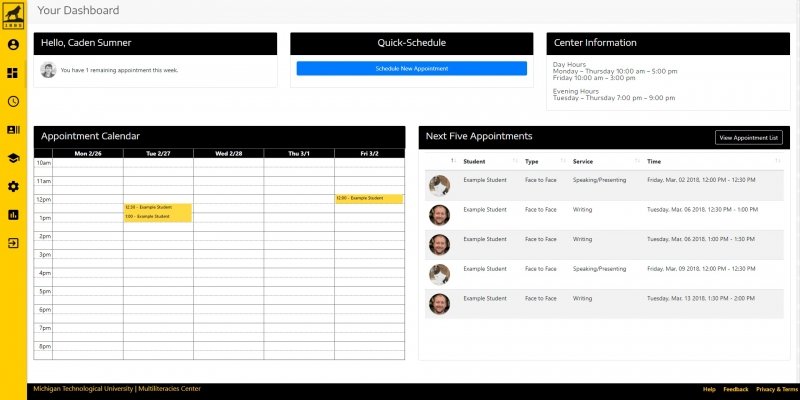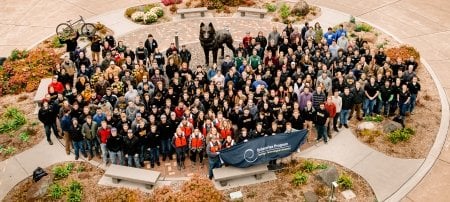Problem: Scheduling learning center appointments. Solution: Apply education; develop online scheduling program.
Maybe you've heard the claim that Michigan Technological University students are crazy smart. In case you needed proof, meet Caden Sumner, a third-year who is double majoring in computer science and psychology. He’s also a coach at the Michigan Tech Multiliteracies Center (MTMC) and leader of the Human Interface Design Enterprise (HIDE) programming team that developed Timeslot.

Timeslot enables students to schedule appointments in campus learning centers from their mobile devices and computers, instead of having to sign up in person. A combination of factors inspired Sumner to develop the program: his interest in psychology, his first (intimidating) impression in a learning center, his experiences as a coach in the MTMC, and encouragement from his boss and MTMC Assistant Director Bill De Herder.
Sumner says, "We were using a software that was really difficult to use. It was hard to figure out how to schedule appointments. Students didn't like it, coaches hated it. My boss mentioned 'you should do something about that' at about the end of last (academic) year. I said absolutely, I'll give that a go.”
Sumner and his fellow HIDE teammates started working on Timeslot at the start of the fall 2017 semester. Though they didn’t keep track of the hours they put into development, Sumner says it was “a lot.”
Creating His Future
Timeslot went live for the MTMC the first week of spring 2018 classes. The HIDE team is taking a soft rollout approach so as to catch and fix all program bugs and prevent a huge scheduling snafu. The math lab will implement the software in the fall, and plans for the biology lab are in the works. Sumner and his team hope that in time all 17 University learning centers will adopt the system.

Dashboard/Interface of Timeslot after login
But the ultimate goal is to pitch the program to other colleges, "first regionally, so if something really bad happens we can drive there. Then we’ll send it out as a public service where people can pay us to host it for them. That way, we don't have to go to any location, and we'd have full control of it. The long-term goal is to see what other needs haven't been met with EdTech software and what we might be able to do for that," Sumner says.
The HIDE team has been working on branding, marketing and establishing Timeslot as an LLC. What started as a way to meet a need on campus has grown into the blueprints for Sumner’s and his teammates’ future careers. They fit in five hours or more each week on Timeslot. Much of their time has been focused on user testing and redesign. Open to and eager for feedback, Sumner and his teammates have improved Timeslot’s color scheme and ease of use—thanks to students’ suggestions.
“It's still developing. We have a lot of stuff to add, but it's being used—that's the cool part. I'm really excited to have it out there for students working with it and giving us feedback. I think we have 300 appointments scheduled within the system,” Sumner says.
Improving Access
Two big developments for improving Timeslot are on the horizon. Sumner wants to create sign-in stations in labs, “so when you walk into a center, you can tap your ID card and a message will pop up and say ‘Hello, [your name],' and then it will sign you in on the backend.” The team also plans to improve the program for mobile devices. According to Sumner, “Mobile is workable but not the best. You can load it up but it's a bit finicky. I think 30 percent of the people that use (Timeslot) are on tablets and phones, so we definitely need to put the emphasis on mobile development.”
Sumner encourages Tech students to try Timeslot and provide feedback, especially if they find any bugs. He and his team are eager to improve the program to increase students’ likelihood of going to learning centers. At its essence, Timeslot is a tool that eliminates a barrier to students’ academic success.
“With the old system, it felt like you really had to work to get an appointment scheduled, and if it's something people are already nervous about, they’re just going to stop. They're not going to try to get their work critiqued. Now it's just three steps, click a button, and you're good to go.”
Just one crazy smart Michigan Tech student helping to assure other Michigan Tech students are crazy smart, too.
Michigan Technological University is an R1 public research university founded in 1885 in Houghton, and is home to nearly 7,500 students from more than 60 countries around the world. Consistently ranked among the best universities in the country for return on investment, Michigan's flagship technological university offers more than 185 undergraduate and graduate degree programs in science and technology, engineering, computing, forestry, business, health professions, humanities, mathematics, social sciences, and the arts. The rural campus is situated just miles from Lake Superior in Michigan's Upper Peninsula, offering year-round opportunities for outdoor adventure.






Comments